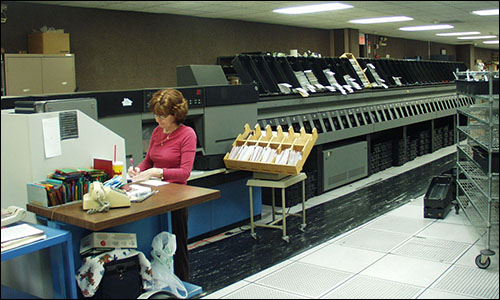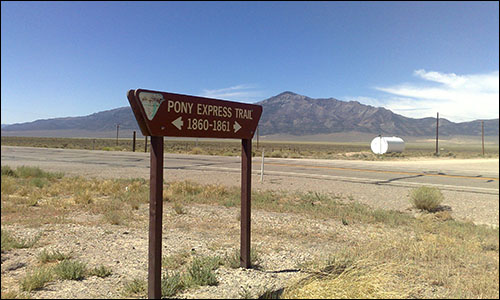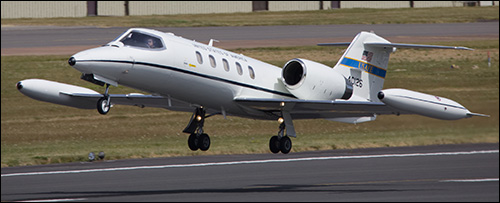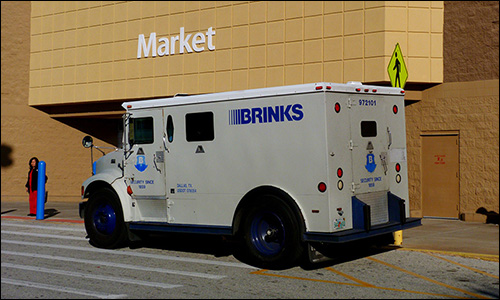We’re fast approaching the 20-year anniversary of the Check Clearing for the 21st Century Act, also known as Check 21 – the 2003 law that allowed banks to settle check payments by exchanging scanned images of checks, rather than the physical paper checks themselves. With well over 99 percent of checks cleared electronically today, it’s safe to say that the law was truly a transformative event for the industry.

Going digital had an immediate impact on the bottom line for banks, saving tens or hundreds of millions of dollars annually in processing costs, while simultaneously lowering the amount of time that money was tied up in transit. What’s been largely forgotten over the past 20 years is exactly what “in transit” used to mean before the Digital Age: thousands of private airplane flights per week, logging close to a hundred million miles per year, dedicated just to transporting checks. After two decades of Check 21, the cumulative environmental benefits of paperless clearing are staggering.
As the astute reader may recall, the original purpose of electronic check clearing wasn’t to save the environment, or to speed up the clearing process, or even to save money. Those were all certainly welcome side effects, but the real reason the Check 21 law was passed was to ensure the reliability of the banking system itself. As strange as it may sound to us in 2022, back at the turn of the century, millions of paper checks each night were literally loaded aboard private aircraft and flown around the country in order to arrive at their respective clearing banks by the next morning. When all U.S. air traffic was grounded following the September 11, 2001 attacks, it also inadvertently caused the check clearing process to come to a screeching halt, creating a financial logjam that took weeks to unravel.
It was that unexpected shock that prompted Congress to take action — legalizing electronic clearing so that physical transport via aircraft would no longer be a weak link in the system. The Check 21 Act was passed in October 2003, and took effect in October of the following year.
A Modern-Day Pony Express?

Were it still in use today, the process of flying checks to their destinations would almost certainly be excoriated as wasteful and careless; but prior to the Digital Age, the fact is, there just weren’t any other good ways to do it. Exchanging checks by train or by truck would have resulted in clearing times of a week, maybe two weeks. (Until they switched to electronic clearing in the late 2010s, British banks primarily exchanged checks by ground transport, a process that typically took up to six business days – in a country the size of California.) Besides the obvious inconvenience to customers of not being paid for several days, it was estimated in 1996 that even a single day’s worth of paper checks cost about $1.5 million in interest nationwide for every day they were tied up in transit. Apply a week’s delay to every check for an entire year, and you’ve got a drain of $3-4 billion. That figure is not adjusted for 25 years’ worth of inflation or today’s higher interest rates.
Using commercial air cargo wasn’t an appealing option for American banks, either, for a variety of reasons. One was that overnight cargo service simply wasn’t available in most places with the tight schedule and to all the destinations that the banking system required. Another was that the industry wasn’t keen on handing over loads that might legally be worth billions of dollars to a general carrier and depending on them to deliver it safely and on time. While there were certain cases in which commercial carriers did fit the bill for specific routes, for the most part, the banks operated what was effectively their own air courier service.
Perhaps an appropriate comparison for our old check clearing flights would be the Pony Express service of the old American West. Despite being the fastest means of cross-country communication for a brief period in the 1860s, it was no match for more efficient modern technology. The Pony Express went out of business on October 26, 1861, a mere two days after the completion of the first transcontinental telegraph line — perhaps the first-ever example of electronic telecommunications displacing a physical service on a nationwide scale. It would take another 143 years until the same could be done for check processing. To be sure, it’s incredible that it took such a long time to make the (seemingly) simple jump from transmitting text to transmitting images, and it’s tempting to think that the reason is because the industry was resistant to change. More likely, though, it goes to show just how many technological advances were necessary to accomplish the reliable transmission of images. Remember, the United States was the first country in the world to move to full image-based clearing, and many others are still in the process of making the change today!
Calculating the Environmental Impact

It’s natural to wonder today: How high was the environmental impact of all those check-clearing flights, and how much cleaner did the industry become by going paperless? Pinning down a precise figure is tough, partly because it’s difficult to reach back twenty years and find out exactly how many planes were employed for the purpose; but we can certainly get a good ballpark estimate. A 1996 Washington Post article pegs the Federal Reserve’s own fleet at 47 planes – but those weren’t the only aircraft used for moving money around. The same article states that U.S. Check Airlines (now AirNet, a part of Kalitta Charters) used 27 jets and 50 turboprops to operate a parallel service for the country’s largest banks. By 2005, the size of AirNet’s fleet had reportedly risen to 128. Another source found that one-quarter of the 400-plus Mitsubishi MU-2 turboprops in the entire United States were under contract with the banking industry as of early 2004.
While these weren’t the only players in the market, or the only types of planes in the check-airmail business, a cautious estimate of 50 Learjets and 100 propeller aircraft seems a reasonable starting point. Since the cargo being carried never came anywhere close to the maximum weight allowance for either type of plane, the type of plane used was a straightforward matter of distance: turboprops on any route short enough for one to cover in the allotted time; the more expensive jets on anything longer. For that reason, we would expect the roughly 2-to-1 ratio of turboprops to jets to have held up across the industry.
At minimum, then, the paper check clearing system accounted for 300 flights per night, five nights per week excluding holidays – a staggering 75,000 flights per year. The real figure is probably even higher, as some of the planes would make a second round-trip journey each night to transport batches of checks that arrived at the airport later. Even sticking with the lower figure, though, that’s 1.35 million flights between the enactment of the Check 21 Act and the end of 2022; or 1.5 million by the twentieth anniversary of the go-live date.
Naturally, the check-clearing flights didn’t stop immediately when the new rules came into effect, taking a few years to die out completely. By 2010, 99 percent of checks were processed as images, and the Federal Reserve Bank had downsized its paper check processing network from 45 locations nationwide to a single site in Cleveland. AirNet itself had already relocated its hub by 2008 as it transitioned its business to that of a regular air freight carrier. The air transport services for checks didn’t disappear quite as quickly as the Pony Express did, but clearly the advantages to electronic processing were so huge that the move was a swift one. It’s a reasonable guess that out of the past 18 years since Check 21, at least 14 or 15 years’ worth of flights were eliminated. Call it an even million flights so far; perhaps as many as 1.15 million fewer flights by the 20-year anniversary.
How much of a boon to the environment has it been to eliminate all that “air time?” One way to look at it would be in terms of miles flown. Without a real way of cataloguing every single flight that would have taken place, a simpler way of calculating that might be assuming that each plane flew a “full” overnight schedule that consisted of roughly six hours in the air. That would give the faster Learjet an average range of 1,500 miles in each direction, with their propeller-driven counterparts topping out between 750 and 1,000.
Of course, some routes would be a little longer than that, and some shorter, but on average, we’d be looking at about 150,000 total miles for the jets and 150,000-200,000 miles for the turboprops per night. Carried out over a full year, that’s a minimum of 75 million miles flown or a maximum of 87.5 million; over two decades, it’s between 1.5 billion and 1.75 billion miles.
It would be convenient if we could calculate fuel usage by taking those numbers and dividing them by the aircraft’s miles per gallon – but planes work a little differently than cars in that respect. Their fuel consumption is typically calculated in gallons per hour, since many factors including airspeed, altitude, travel direction, and wind conditions can all impact the distance traveled on a given amount of fuel.
For a Learjet 35A – one of the types that would’ve been common during the paper check transport era – average fuel usage is given as 197 gallons per hour. The MU-2 turboprop comes in much lower, at 75 gallons per hour, albeit also at a substantially lower speed. Many of the common smaller piston-engine aircraft of the time tended to burn about 30 gallons per hour, give or take a couple; although these featured even slower speeds and lower ranges, and it’s not clear how many were among the mix of propeller aircraft in the Fed’s fleet or the private ones.
If we assume roughly the same six hours of nightly flying time, however, the calculation is still rather simple: Each jet would have consumed an average of about 1,200 gallons of fuel per night, and the propeller planes around 400 gallons apiece. That equates to 60,000 for the jets and 40,000 for the turboprops, or a nice round 100,000 gallons in total. All told, that’s 25 million gallons of jet fuel per year, or half a billion in a 20-year period. At 21.50 pounds of carbon dioxide per gallon, that’s more than 10 billion pounds of greenhouse gas emissions saved by Check 21, a number that will only keep increasing over time.
Don’t Forget the Last Mile

And that’s only for the airplanes. Not accounted for in those calculations is the fuel that would’ve been used to transport all those checks to and from the airport, usually by armored truck. To collect the deposits from the approximately 70,000 U.S. branches that existed around the turn of the century, and then send them back home, was no trivial undertaking.
Fortunately, the arriving checks didn’t have to go all the way back out to individual branches on the second leg of the trip – just to regional centers where the receiving banks did their back-end processing. So, most of the mileage came on the front end, when the checks were being collected from branches. If we assume a very short 2 miles between branch pickups on average, we get an extra 140,000 miles of driving every business day to make pickups from all of them. With armored cars of the time averaging 6-8 miles per gallon of diesel, that’s another 20,000 gallons per night.
It could be argued that not all of that was directly related to check processing, since bank branches have lots of other things that require frequent armored car visits, especially cash. So, many of those trips would have happened anyway. And it’s also true that some checks didn’t make the initial part of the journey by armored truck, either, as ordinary vehicles were sometimes used for low-risk pickups. Even ignoring that, though, the trips from regional collection points to and from the airport were 100 percent related to paper checks, and those were nothing to write off. Let’s assume each financial institution’s regional center was located an average of 10 miles from the nearest airport hosting check transport flights (again, a very generous estimate). With around 7,000 banks and 10,000 credit unions in existence at the time, that’s a lot of driving. Even if we assume each armored car was able to save time by visiting, say, 10 different collection points before heading to the airport, we’ve still got 17,000 miles of driving and 2,500 gallons of diesel per night, on each end – so 34,000 miles and 5,000 gallons total.
Over the course of a year, then, the ground transport portion of the paper check clearing operation would use a quarter-million gallons of diesel and generate 5.6 million pounds of carbon emissions – if we only count the regional-center-to-airport trips and not the branch visits. At the two-decade mark, that projects to 112 million pounds of CO2. If we assign a portion of the daily branch routes to check transport, we could conceivably double or triple that. That’s still only a small fraction of what the planes consumed, but nonetheless nothing to ignore.
It’s worth noting that, alongside the elimination of all that driving, improving technology has also helped armored trucks increase their mileage over the intervening 20 years. As local fleet vehicles, they’ve also been singled out as good candidates for alternative fuels such as natural gas, electricity, or even hydrogen. Even after our flying checks were taken out of the equation, cutting down on pollution and environmental impact still remains an ongoing process.
If nothing else, this article should illustrate that operating a nationwide system that required overnight transaction times was really, really difficult before computers became reliable enough to do the job instead. Coordinating rapid physical transport between tens of thousands of endpoints scattered over millions of square miles took a tremendous amount of effort, and yes, used a lot of fuel in the process. But then, waiting weeks for a payment to go through wasn’t a very realistic option either. Perhaps the best way to judge our former “fly-by-night” check transport system is to take it for what it was: A logistical marvel for its time, but also one that it’s good we’ve left behind.





